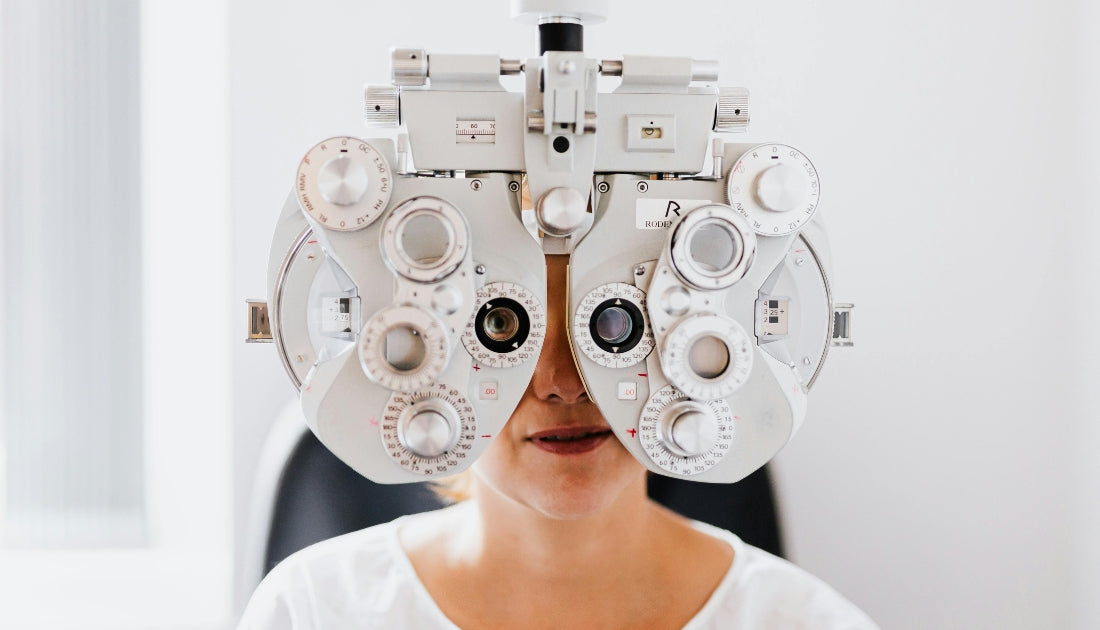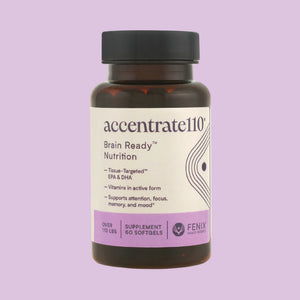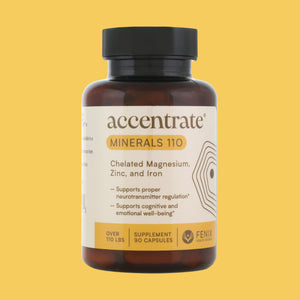Understanding Macular Degeneration and Omega-3s/Lysoveta: What You Need to Know

As people in developed countries get older, the predicted rate of age-related macular degeneration (AMD) rises, making it necessary to find effective ways to support vision health. AMD is one of the causes of visual impairment among older adults.
Doctors and researchers have recommended omega-3 fatty acids (often derived from fish oils) as a way to slow AMD progression. But how effective are these fatty acids in managing macular degeneration?
In this article, we'll examine the role of omega-3 fatty acids and look at findings from research related to AMD, such as the Age-Related Eye Disease Study (AREDS-2).
What is Age-Related Macular Degeneration (AMD)?
AMD is a degenerative eye condition that affects the macula, a small but critical region of the retina at the rear of the eye.
The macula is responsible for our central vision, which is necessary for performing daily tasks such as reading, driving, and recognizing faces. AMD is categorized into two types: dry and wet AMD.
If you develop dry AMD, you’ll slowly lose your vision as your retina breaks down. However, if you develop wet AMD, you’ll lose your vision quickly due to the growth of abnormal blood vessels.
The Prevalence of AMD in Developed Countries
AMD is the leading cause of blindness and visual impairment in developed countries, particularly among people over the age of 50. The estimated prevalence of AMD in European ancestry populations is 1.4% at age 70, with this figure rising significantly by age 90 (Wong et al., 2014). AMD has become an important health concern globally because its impact rises as the population increases.
Progression of AMD and Its Effects on Vision
-
Age-related macular degeneration progresses from early AMD, where there may be no noticeable vision loss.
-
It can advance to geographic atrophy or choroidal neovascularization (CNV) in wet AMD.
-
When it leads to CNV in wet AMD, it ultimately impairs your central vision.
-
The condition can affect both of your eyes, making everyday activities challenging.
Current Treatments for AMD
AMD has no cure yet, but doctors are using current treatments to slow its progression and improve quality of life.
For instance, ophthalmologists inject anti-VEGFs directly into the eyes of patients with wet AMD. Anti-VEGF medications inhibit the action of the Vascular Endothelial Growth Factor (VEGF) protein that promotes the growth of abnormal, leaky blood vessels. By stopping this process, this treatment can maintain or even improve their vision.
On the other hand, for patients with dry AMD, a specific high-dose formulation of antioxidants (vitamins C and E), zinc, copper, lutein, and zeaxanthin can slow the progression of intermediate AMD to advanced stages.
This therapy helps those with either form of AMD by preserving remaining vision and slowing down the disease. It doesn’t repair or reverse the damage that has already occurred.
What the AREDS-2 Study Found About AMD Treatment
Researchers designed the AREDS-2 clinical trial to assess the effectiveness of various supplements in preventing AMD progression. The study’s participants (50-80 years of age) were more than 4,200, and all of them were at moderate to high risk of developing advanced AMD (AREDS-2 Research Group, 2013).
The AREDS-2 Supplement
Study participants in AREDS-2 received the first AREDS formula, which included antioxidant vitamins C and E, zinc, and beta-carotene. The researchers randomly gave the participants additional supplements such as advanced omega-3 fatty acids (EPA and DHA), lutein, and zeaxanthin, or a placebo (a look-alike substance with no active ingredients).
What Was Tested in the AREDS-2 Study?
The main goal of AREDS-2 was to test whether adding omega-3 fatty acids and carotenoids (lutein and zeaxanthin) to the AREDS formula would reduce the risk of AMD progression.
Omega-3 fatty acids, particularly EPA and DHA, found in fish oils, were tested. The research group considered these fatty acids as potential agents that can slow AMD progression by reducing inflammation and oxidative damage to the retina.
They also assessed lutein’s and zeaxanthin’s ability to reduce oxidative stress and protect retinal cells. The mean age of the study participants was 74 years, and the clinical trial ran for 5 years.
Main Findings of the AREDS-2 Study
The primary finding of AREDS-2 was that adding omega-3 fatty acids (EPA and DHA) to the previous AREDS formula provided no additional benefit in preventing the progression of AMD. This was a surprising finding for some of the researchers, as previous observational studies had suggested a connection between omega-3 intake and lower AMD risk. This finding means that the observed differences were small (maybe due to chance) and couldn't be confidently attributed to the supplement itself.
While the primary analysis of the overall study population didn't show much benefit for lutein and zeaxanthin, a subgroup analysis found a statistically significant benefit for participants who had low dietary intake of these nutrients at the beginning of the study. This means that the supplements were most helpful for people who were already deficient in them.
Implications of the AREDS-2 Study for AMD Patients
For individuals with AMD, the findings from the AREDS-2 study provide valuable insights. While traditional omega-3 supplements did not offer significant benefits, lutein and zeaxanthin supplementation may be beneficial for those with low dietary intake of these carotenoids. AMD patients should consider incorporating lutein and zeaxanthin-rich foods or dietary supplements into their daily regimen.
Substitution of Beta-Carotene with Lutein and Zeaxanthin
AREDS-2 also explored the substitution of beta-carotene with lutein and zeaxanthin among smokers. Interestingly, beta-carotene has been associated with an increased risk of lung cancer in smokers (The Alpha-Tocopherol, Beta Carotene Cancer Prevention Study Group, 1994). This makes the switch to lutein and zeaxanthin a safer option. The study also looked for any adverse effects of the new formula but found none.
The Role of Lutein and Zeaxanthin in AMD
Lutein and zeaxanthin are carotenoids found in high concentrations in the retina. They act as antioxidants, protecting our retina from oxidative damage and filtering harmful blue light. Lutein and zeaxanthin are commonly found in leafy greens, egg yolks, and other dietary sources.
How Clinical Trials Define the Science of AMD
The conclusions drawn from major studies like AREDS-2 are not subjective. They’re the result of a rigorous scientific process. A clinical trial is the standard for testing the effectiveness and safety of a new intervention. When it comes to age-related macular degeneration, researchers have carefully designed studies to ensure the results are reliable and valid.
First, researchers will identify study participants who meet specific inclusion criteria, such as being at a moderate to high risk of developing advanced AMD. Then the researchers randomly assign participants to one of several treatment groups. The randomized, controlled trial helps rule out the possibility that observed changes are due to chance or other lifestyle factors.
Over the study period, researchers carefully monitor participants for changes in their AMD status, visual acuity, and overall visual function. An important part of this process is tracking any adverse events or serious adverse events that occurred.
An adverse event is any undesirable medical occurrence, regardless of its relationship to the study product, while a serious adverse event is life-threatening or requires hospitalization.
This comprehensive approach is why the findings from a clinical trial carry so much weight. The careful reporting of these events is necessary for creating a thorough safety profile for the oral supplement being tested.
Common Beliefs About Omega-3 and Eye Health
AREDS-2 researchers believe that Omega-3 fatty acids protect eye health, suggesting a potential connection between omega-3 intake and reduced risk of developing AMD. Before major clinical trials like AREDS-2, a body of observational and epidemiological evidence suggested that people with diets high in omega-3s (particularly from fish) had a lower risk of developing AMD.
Due to these beliefs, people have marketed fish oil supplements as a solution for slowing the progression of AMD. The levels of these important fatty acids in a person's red blood cell membrane are often used as a biomarker to accurately measure an individual's dietary intake.
Expert Opinion on Omega-3 Fatty Acids for AMD
Experts, including those involved in the AREDS-2 trial, have suggested that while omega-3 fatty acids are important for general eye health and overall well-being, they don’t provide a solution for AMD. More so, the evidence from clinical trials doesn’t support their use as a primary intervention for slowing AMD progression.
Why a Diet Rich in Omega-3s Still Matters for Eye Health
There's a large body of evidence from research groups like AREDS-2 suggesting that a diet rich in fatty acids is important for eye health. This is despite the mixed results from clinical trials on omega-3 supplements. The distinction lies in the difference between a high-dose oral supplement and the benefits of a whole-food dietary pattern.
Numerous epidemiological studies have demonstrated a strong inverse relationship between the dietary intake of oily fish and the risk of developing advanced AMD (Chong et al., 2009). This means that people who regularly consume oily fish like salmon and sardines have a lower risk of AMD. Researchers attribute this to the health benefits of omega-3s.
More evidence points to the anti-inflammatory properties of omega-3 fatty acids as a cause for the reduced risk of developing AMD, particularly EPA, which can help counteract the chronic inflammation that contributes to AMD.
Furthermore, docosahexaenoic acid (DHA) is a major structural component of our retina itself, making its dietary intake necessary for maintaining retinal function. While some of the fatty acids from vegetable oils, such as alpha linolenic acid (ALA) found in flaxseed and olive oil, can be converted into EPA and DHA, the conversion rate is very low. This is why fish oils are often the best.
When you focus on a balanced diet rich in these beneficial fats, you can benefit from omega-3 nutrients and healthier lifestyle habits that often come with such diets.
The Future of AMD Treatment: Beyond AREDS-2 and Omega-3s
While the AREDS-2 trial provided definitive answers regarding the use of omega-3 supplements for AMD prevention, the conversation about macular degeneration and diet is not over. Today, further research is exploring the relationship between diet and eye diseases.
Some recent systematic reviews are revisiting the AREDS-2 data, as well as other studies, to better understand the role of different omega-3s (Chen et al., 2024). Researchers are investigating whether specific types of fatty acids, like EPA and DHA, might have a different impact on our retinal function. DHA, in particular, is a major structural component of the retina and is necessary for visual acuity and the health of the retinal pigment epithelium.
In addition, scientists like Chen et al. (2023) are using animal models, such as the mouse model, to study the underlying biological mechanisms of AMD. These models allow researchers to test the effects of specific nutrients or genetic modifications in a controlled environment. For instance, a high-fat diet in a mouse model has been shown to change retinal genes, increasing susceptibility to AMD (BrightFocus Foundation, 2021).
This provides new avenues for understanding the complex relationship between genetics, environment, and disease progression. Other studies, like the Alienor Study, are also investigating the potential role of different nutrients, such as vitamin D, in reducing the inflammatory response that contributes to late AMD.
The Role of Lysoveta: A New Approach to Omega-3 Delivery
While the AREDS-2 trial provided clear answers about traditional omega-3 supplements, a new area of research is focusing on delivery systems for these nutrients. One such innovation is Lysoveta® LPC, a patented ingredient that binds omega-3s (EPA and DHA) to a carrier molecule called lysophosphatidylcholine (LPC). The hypothesis is that the omega-3s used in the AREDS-2 trial were not absorbed efficiently enough to reach the retina.
By using the LPC carrier, Lysoveta replicates the body's natural transport system, potentially allowing for more efficient delivery of these essential fatty acids to the eyes. This represents an approach to the question of whether omega-3s can still play a role in slowing the progression of AMD, shifting the focus from the nutrient itself to how it’s delivered to the targeted tissue.
At Fenix Health, we’ve created a product with Lysoveta® LPC called Accentrate Omega Max. Accentrate® Omega Max with LYSOVETA® LPC is specifically formulated with omega-3s, LPC-EPA, and LPC-DHA, to support attention, memory, and mood for those over 110 lbs needing maximum absorption. It provides brain-ready nutrition, meaning all ingredients are in the form the body recognizes and it’s used by the brain to support mental health.
The Role of Other Key Nutrients for Eye Health
Beyond omega-3 fatty acids and the carotenoids in the AREDS-2 formula, other vitamins and minerals are also important in maintaining eye health.
-
Zinc: This essential mineral is found in high concentrations in our retina and retinal pigment epithelium (RPE). It’s an important component of the original AREDS formula. Research has shown that it helps transport vitamin A from our liver to the retina to produce melanin, a protective pigment (Medical News Today, 2023). A recent meta-analysis confirmed the beneficial association between zinc intake and a reduced risk of AMD, demonstrating that this mineral is a key component in a comprehensive strategy to manage the condition (Chen et al., 2024).
-
Vitamin A: Crucial for night vision, Vitamin A is a component of the protein rhodopsin, which allows our eyes to see in low-light conditions. A deficiency in this vitamin can lead to night blindness and, in severe cases, even total blindness, though this is rare in developed countries (AAO, 2024).
-
Vitamin D: While not part of the AREDS formula, recent research suggests that having adequate levels of Vitamin D may have a protective effect against AMD. Its anti-inflammatory and antioxidant properties may help counteract the oxidative stress and inflammation thought to contribute to the disease (MDPI, 2023). However, the evidence is still mixed, and it’s not currently recommended as a primary treatment.
Conclusion
As further research continues, it's important that those with AMD focus on a holistic approach to their eye health. This includes proper nutritional supplementation, a diet rich in antioxidants, and regular eye checkups.
References
-
The Age-Related Eye Disease Study 2 (AREDS-2) Research Group. (2013). Lutein + zeaxanthin and omega-3 fatty acids for age-related macular degeneration: The AREDS-2 randomized clinical trial. JAMA, 309(19), 2005–2015.
-
The Alpha-Tocopherol, Beta Carotene Cancer Prevention Study Group. (1994). The effect of vitamin E and beta carotene on the incidence of lung cancer and other cancers in male smokers. The New England Journal of Medicine, 330(15), 1029–1035.
-
American Academy of Ophthalmology. (2024). What Is Vitamin A Deficiency?
-
BrightFocus Foundation. (2021, December 1). A High-Fat Diet Alters Genes and Susceptibility to Age-Related Macular Degeneration, New Research Shows.
-
Chen, J., Zhao, F., Li, C., Ma, X., Liu, Y., Gu, H., Guo, M., He, S., Han, R., Ma, C., Liu, F., & Li, Y. (2023). Comparative analysis of molecular landscape in mouse models and patients reveals conserved inflammation pathways in age-related macular degeneration. Investigative Ophthalmology & Visual Science, 64(14), 16.
-
Chen, Z., Cao, H., Wu, Y., Liu, X., Huang, J., Zhu, Y., Ma, Z., Fang, W., & Wei, S. (2024). Association between fatty acid intake and age-related macular degeneration: A meta-analysis. Frontiers in Nutrition, 11, 1403987.
-
Chong, E. W.-T., Kreis, A. J., Wong, T. Y., English, D. R., & Giles, G. G. (2009). Dietary Omega-3 Fatty Acid and Fish Intake in the Primary Prevention of Age-Related Macular Degeneration: A Systematic Review and Meta-analysis. Archives of Ophthalmology, 127(6), 705–711.
-
MDPI. (2023). The Roles of Vitamin D and Polyphenols in the Management of Age-Related Macular Degeneration: A Narrative Review. Nutrients, 15(8), 1958.
-
Medical News Today. (2023). 4 Essential Vitamins for Eye Health.
-
Merle, B. M. J., Delyfer, M.-N., Korobelnik, J.-F., Buaud, B., Rougier, M.-B., Cougnard-Grégoire, A., Baudouin, C., Barberger-Gateau, P., & Delcourt, C. (2017). Association of vitamin D with age-related macular degeneration in the Alienor study: results on 25(OH)D plasma concentrations and genetic variants. Nutrients, 9(8), 834.
-
National Eye Institute (NEI). (2001). Antioxidant Vitamins and Zinc Reduce Risk of Vision Loss from Age-Related Macular Degeneration.
-
Wong, W. L., Su, X., Li, X., Cheung, C. M. G., Klein, R., Cheng, C. Y., & Wong, T. Y. (2014). Global prevalence of age-related macular degeneration and disease burden projection for 2020 and 2040: A systematic review and meta-analysis. The Lancet Global Health, 2(2), e106-e116.
- Tags: lysoveta omega-3s vision health




